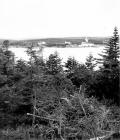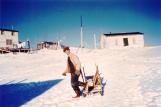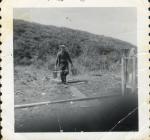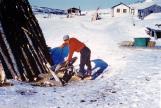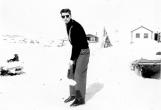1
The section of a small community, known as The Bottom, in the deep of winter1958
St. Lewis, Newfoundland, Canada
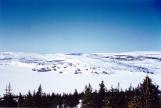
2
In the 1950's, with the threat of the cold war and the possibility of bombardment over North America, the RCAF and the USAF started a joint venture called the Pinetree Line Radar Defence System. There were to be 6 heavy radars set up between Hopedale and St. John's. To increase low altitude coverage along this line, some backup for these radars, a light radar called a gap filler, was placed between the heavy radars. Fox Harbour(St. Lewis) was selected as one of the gapfiller sites.As the planning for these new radar sites was being done, the residents of this small isolated fishing village were unaware that their quiet community was about to change forever. In early June 1954, 2 large planes landed in the harbour after, flying over for a week, peeking everyone's curiousity, as planes were unusual during those days. Men from the harbour went out to greet them. Soon all was revealed, there was to be a Radar Base built on Fox Harbour Hill, and these men were the surveyors. The planes, helicopters, and large supply ships were common place in the community as this project got underway. Equipment, such as Bulldozers and vehicles, not even imaginable, were brought in, which amazed the community. A road was built from the waters edge to the top of the hill, water was pumped up from Fox Harbour Pond, by heated pipe. Technology like electricity, was unseen before.
That fall construction on the Base started and nearly every man in the Harbour went to work. There was very little fishing done for the next couple of years, as everyone was into construction, the workers were paid in American currency. In February 1957, the site became fully operational, staffed by mostly American Servicemen. There were 16-20 Americans, a couple of Canadians, mostly from Newfoundland, who operated the power plant.
4
At the time of the American's arrival, Fox Harbour (today St. Lewis) was still living quite primitively.5
A shot of Fox Harbour Bottom. A snowmobile and Dog Team on the Harbour in the foreground.1959
St. Lewis, Newfoundland, Canada
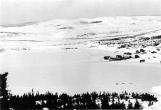
6
Hauling wood home, a regular chore for men and dogs during the winter in that time1959
St. Lewis, Newfoundland, Canada
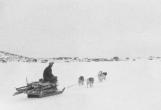
8
This method to carry water was used until wells were drilled in early 80's.10
Loder's Point... The hub of the community and the only store in town... Now our Museum.1959
St. Lewis, Newfoundland, Canada
